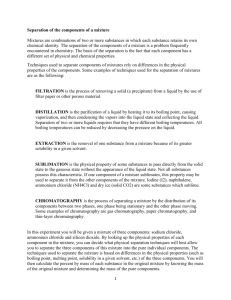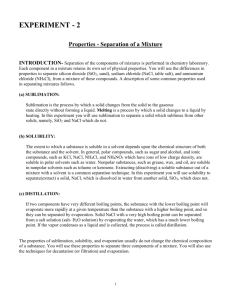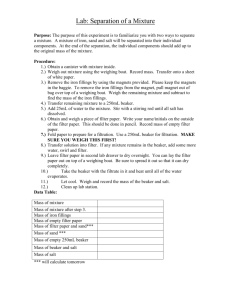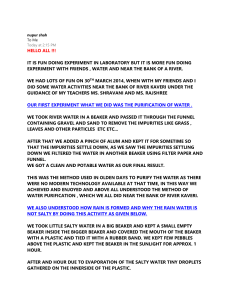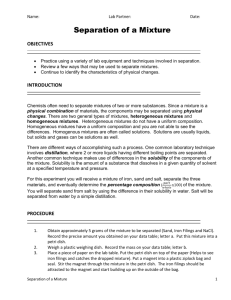Procedure Physcial Separation
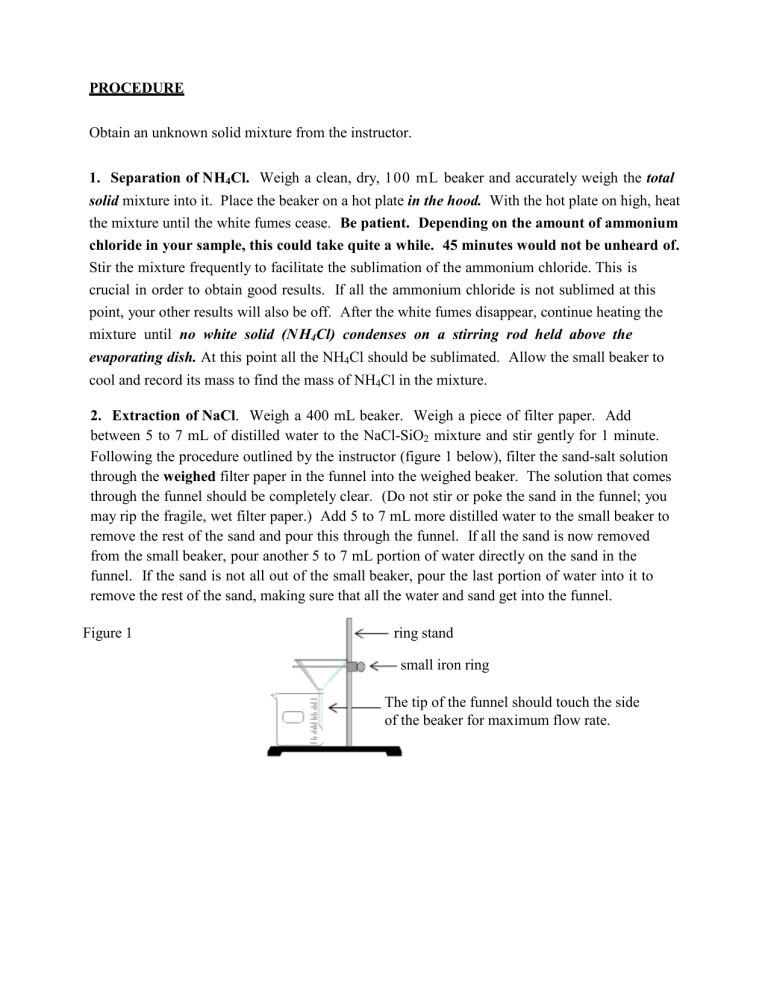
PROCEDURE
Obtain an unknown solid mixture from the instructor.
1. Separation of NH
4
Cl. Weigh a clean, dry, 100 mL beaker and accurately weigh the total solid mixture into it. Place the beaker on a hot plate in the hood. With the hot plate on high, heat the mixture until the white fumes cease. Be patient. Depending on the amount of ammonium chloride in your sample, this could take quite a while. 45 minutes would not be unheard of.
Stir the mixture frequently to facilitate the sublimation of the ammonium chloride. This is crucial in order to obtain good results. If all the ammonium chloride is not sublimed at this point, your other results will also be off. After the white fumes disappear, continue heating the mixture until no white solid (N H
4
Cl) condenses on a stirring rod held above the evaporating dish. At this point all the NH
4
Cl should be sublimated. Allow the small beaker to cool and record its mass to find the mass of NH
4
Cl in the mixture.
2. Extraction of NaCl . Weigh a 400 mL beaker. Weigh a piece of filter paper. Add between 5 to 7 mL of distilled water to the NaCl-SiO
2 mixture and stir gently for 1 minute.
Following the procedure outlined by the instructor (figure 1 below), filter the sand-salt solution through the weighed filter paper in the funnel into the weighed beaker. The solution that comes through the funnel should be completely clear. (Do not stir or poke the sand in the funnel; you may rip the fragile, wet filter paper.) Add 5 to 7 mL more distilled water to the small beaker to remove the rest of the sand and pour this through the funnel. If all the sand is now removed from the small beaker, pour another 5 to 7 mL portion of water directly on the sand in the funnel. If the sand is not all out of the small beaker, pour the last portion of water into it to remove the rest of the sand, making sure that all the water and sand get into the funnel.
Figure 1 ring stand small iron ring
The tip of the funnel should touch the side of the beaker for maximum flow rate.
3. Drying Of SiO
2
. Carefully place your wet filter paper cone in which the sand is contained onto a watch glass. There is no need to unwrap the cone. Allow the paper and sand to dry completely till after school. One lab partner must come after school to weigh the sand and filter paper to find the mass of SiO
2 in the sample.
4. Drying of NaCl. While the SiO
2 is drying, set the large beaker containing the NaCl solution on a hot plate. Gently heat the solution until the salt is dry. (Start at a medium to high setting and then decrease the setting as the water evaporates.) Make sure that all the condensation is gone from the sides of the beaker. If the salt appears to be dry but there is still water on the beaker walls, see the instructor. If the salt pops out of the beaker, carefully remove the beaker from the hot plate and see the instructor. When the beaker is cool (check the bottom), weigh it to find the mass of NaCl in the original mixture.
5. Percent by Mass. Determine the percent by mass of each component in your mixture using the following formula:
% of Component A =
grams of component A
100 x grams of original sample
DATA AND CALCULATIONS
Unknown Number
1. Mass of evaporating dish
2. Mass of evaporating dish plus original sample
3. Mass of original sample
4. Mass of evaporating dish plus NaCl and SiO
2
5. Mass of NH
4
Cl in original sample
6. Mass of filter paper plus dry SiO
2
7. Mass of dry filter paper
8. Mass Of SiO
2 in original sample
9. Mass of beaker plus dry NaCl
10. Mass of beaker
11. Mass of NaCl in original sample
Calculations: Show all work!
1. Percent NH
4
Cl in original sample
2. Percent SiO
2 in original sample
3. Percent NaCl in original sample
4. Percent lost
